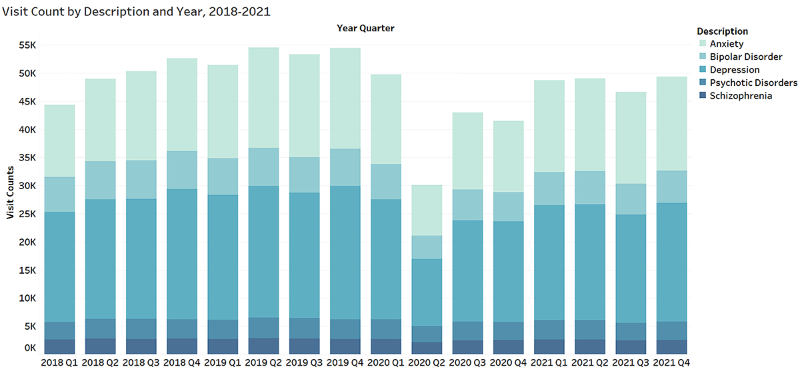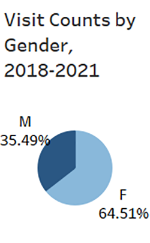Vol. 66, Issue 18
View more issues of The Valued Voice
Sign Up for WHA's Newsletter
Click here to view past issues
IN THIS ISSUE
- Will You Be on the First Contributor List for 2022?
- New AHA Report Highlights Dramatic Spike in Health Care Input Costs
- Medicare Advantage Plan Practices Impede Beneficiary Access to Necessary Care
- Gov. Evers Honors Wisconsin Hospitals in Hospital Week Proclamation
- Fast Facts from the WHA Information Center: May is Mental Health Month
EDUCATION EVENTS
Jan. 14, 2026
Caring for Wisconsin’s Caregivers Well-Being First Champion Challenge for Credentialing KickoffJan. 28, 2026
2026 WHA Health Care Leadership AcademyFeb. 25, 2026
2026 Advocacy DayClick here to view education event calendar
View more issues of The Valued Voice
Sign Up for WHA's Newsletter
Thursday, May 5, 2022
Fast Facts from the WHA Information Center: May is Mental Health Month
Since 1949, May has been recognized as Mental Health Month, bringing attention to mental health disorders. Each year in the United States, almost one in five Americans will have a diagnosable mental health illness. According to the Centers for Disease Control and Prevention (CDC), 4.9 million emergency department visits annually involve mental disorders as the primary diagnosis.
Depression is a common mental illness, with an estimated 5% of adults suffering from depression worldwide. In the U.S., roughly 8.4% of adults are diagnosed with major depression. Other common mental disorders include anxiety, addiction/substance use disorder, bipolar disorder, post-traumatic stress disorder and schizophrenia.

 The WHA Information Center analyzed mental health illness visits to hospitals from 2018-2021 to see how the condition impacts Wisconsin patients. While visit counts dipped during the stay-at-home order in the second quarter of 2020, therapy visits to hospitals showed an exponential increase since June 2020. Visit counts for mental health illness have been steady for the past three years. Females have significantly higher visit counts than males. The average age for depression and anxiety visits is around 40 years old.
The WHA Information Center analyzed mental health illness visits to hospitals from 2018-2021 to see how the condition impacts Wisconsin patients. While visit counts dipped during the stay-at-home order in the second quarter of 2020, therapy visits to hospitals showed an exponential increase since June 2020. Visit counts for mental health illness have been steady for the past three years. Females have significantly higher visit counts than males. The average age for depression and anxiety visits is around 40 years old.
The recent COVID-19 pandemic has caused major changes in people’s lives, which can be overwhelming and stressful. Whether it’s job changes, the unknowns of the virus or caring for oneself, the pandemic has drawn increased awareness to mental illness. The health emergency created pressure not only for adults whose work and home lives were disrupted, but also for young people. According to the CDC, “more than a third (37%) of high school students reported they experienced poor mental health during the COVID-19 pandemic, and 44% reported they persistently felt sad or hopeless during the past year.” Even pre-pandemic mental health in youth and high school students was worsening. In 2019, in the U.S., 13% of adolescents were reported to have a major depressive episode, which is a 60% increase from 2007.
There is no single cause for mental illness. The following are factors the CDC says could contribute to risk for mental illness:
Depression is a common mental illness, with an estimated 5% of adults suffering from depression worldwide. In the U.S., roughly 8.4% of adults are diagnosed with major depression. Other common mental disorders include anxiety, addiction/substance use disorder, bipolar disorder, post-traumatic stress disorder and schizophrenia.

 The WHA Information Center analyzed mental health illness visits to hospitals from 2018-2021 to see how the condition impacts Wisconsin patients. While visit counts dipped during the stay-at-home order in the second quarter of 2020, therapy visits to hospitals showed an exponential increase since June 2020. Visit counts for mental health illness have been steady for the past three years. Females have significantly higher visit counts than males. The average age for depression and anxiety visits is around 40 years old.
The WHA Information Center analyzed mental health illness visits to hospitals from 2018-2021 to see how the condition impacts Wisconsin patients. While visit counts dipped during the stay-at-home order in the second quarter of 2020, therapy visits to hospitals showed an exponential increase since June 2020. Visit counts for mental health illness have been steady for the past three years. Females have significantly higher visit counts than males. The average age for depression and anxiety visits is around 40 years old.The recent COVID-19 pandemic has caused major changes in people’s lives, which can be overwhelming and stressful. Whether it’s job changes, the unknowns of the virus or caring for oneself, the pandemic has drawn increased awareness to mental illness. The health emergency created pressure not only for adults whose work and home lives were disrupted, but also for young people. According to the CDC, “more than a third (37%) of high school students reported they experienced poor mental health during the COVID-19 pandemic, and 44% reported they persistently felt sad or hopeless during the past year.” Even pre-pandemic mental health in youth and high school students was worsening. In 2019, in the U.S., 13% of adolescents were reported to have a major depressive episode, which is a 60% increase from 2007.
There is no single cause for mental illness. The following are factors the CDC says could contribute to risk for mental illness:
- Early adverse life experiences, such as trauma or a history of abuse (for example, child abuse, sexual assault, witnessing violence, etc.);
- Experiences related to other ongoing (chronic) medical conditions, such as cancer or diabetes;
- Biological factors or chemical imbalances in the brain;
- Use of alcohol or drugs; and
- Feelings of loneliness or isolation.
Vol. 66, Issue 18
Thursday, May 5, 2022
Fast Facts from the WHA Information Center: May is Mental Health Month
Since 1949, May has been recognized as Mental Health Month, bringing attention to mental health disorders. Each year in the United States, almost one in five Americans will have a diagnosable mental health illness. According to the Centers for Disease Control and Prevention (CDC), 4.9 million emergency department visits annually involve mental disorders as the primary diagnosis.
Depression is a common mental illness, with an estimated 5% of adults suffering from depression worldwide. In the U.S., roughly 8.4% of adults are diagnosed with major depression. Other common mental disorders include anxiety, addiction/substance use disorder, bipolar disorder, post-traumatic stress disorder and schizophrenia.

 The WHA Information Center analyzed mental health illness visits to hospitals from 2018-2021 to see how the condition impacts Wisconsin patients. While visit counts dipped during the stay-at-home order in the second quarter of 2020, therapy visits to hospitals showed an exponential increase since June 2020. Visit counts for mental health illness have been steady for the past three years. Females have significantly higher visit counts than males. The average age for depression and anxiety visits is around 40 years old.
The WHA Information Center analyzed mental health illness visits to hospitals from 2018-2021 to see how the condition impacts Wisconsin patients. While visit counts dipped during the stay-at-home order in the second quarter of 2020, therapy visits to hospitals showed an exponential increase since June 2020. Visit counts for mental health illness have been steady for the past three years. Females have significantly higher visit counts than males. The average age for depression and anxiety visits is around 40 years old.
The recent COVID-19 pandemic has caused major changes in people’s lives, which can be overwhelming and stressful. Whether it’s job changes, the unknowns of the virus or caring for oneself, the pandemic has drawn increased awareness to mental illness. The health emergency created pressure not only for adults whose work and home lives were disrupted, but also for young people. According to the CDC, “more than a third (37%) of high school students reported they experienced poor mental health during the COVID-19 pandemic, and 44% reported they persistently felt sad or hopeless during the past year.” Even pre-pandemic mental health in youth and high school students was worsening. In 2019, in the U.S., 13% of adolescents were reported to have a major depressive episode, which is a 60% increase from 2007.
There is no single cause for mental illness. The following are factors the CDC says could contribute to risk for mental illness:
Depression is a common mental illness, with an estimated 5% of adults suffering from depression worldwide. In the U.S., roughly 8.4% of adults are diagnosed with major depression. Other common mental disorders include anxiety, addiction/substance use disorder, bipolar disorder, post-traumatic stress disorder and schizophrenia.

 The WHA Information Center analyzed mental health illness visits to hospitals from 2018-2021 to see how the condition impacts Wisconsin patients. While visit counts dipped during the stay-at-home order in the second quarter of 2020, therapy visits to hospitals showed an exponential increase since June 2020. Visit counts for mental health illness have been steady for the past three years. Females have significantly higher visit counts than males. The average age for depression and anxiety visits is around 40 years old.
The WHA Information Center analyzed mental health illness visits to hospitals from 2018-2021 to see how the condition impacts Wisconsin patients. While visit counts dipped during the stay-at-home order in the second quarter of 2020, therapy visits to hospitals showed an exponential increase since June 2020. Visit counts for mental health illness have been steady for the past three years. Females have significantly higher visit counts than males. The average age for depression and anxiety visits is around 40 years old.The recent COVID-19 pandemic has caused major changes in people’s lives, which can be overwhelming and stressful. Whether it’s job changes, the unknowns of the virus or caring for oneself, the pandemic has drawn increased awareness to mental illness. The health emergency created pressure not only for adults whose work and home lives were disrupted, but also for young people. According to the CDC, “more than a third (37%) of high school students reported they experienced poor mental health during the COVID-19 pandemic, and 44% reported they persistently felt sad or hopeless during the past year.” Even pre-pandemic mental health in youth and high school students was worsening. In 2019, in the U.S., 13% of adolescents were reported to have a major depressive episode, which is a 60% increase from 2007.
There is no single cause for mental illness. The following are factors the CDC says could contribute to risk for mental illness:
- Early adverse life experiences, such as trauma or a history of abuse (for example, child abuse, sexual assault, witnessing violence, etc.);
- Experiences related to other ongoing (chronic) medical conditions, such as cancer or diabetes;
- Biological factors or chemical imbalances in the brain;
- Use of alcohol or drugs; and
- Feelings of loneliness or isolation.
IN THIS ISSUE
- Will You Be on the First Contributor List for 2022?
- New AHA Report Highlights Dramatic Spike in Health Care Input Costs
- Medicare Advantage Plan Practices Impede Beneficiary Access to Necessary Care
- Gov. Evers Honors Wisconsin Hospitals in Hospital Week Proclamation
- Fast Facts from the WHA Information Center: May is Mental Health Month

